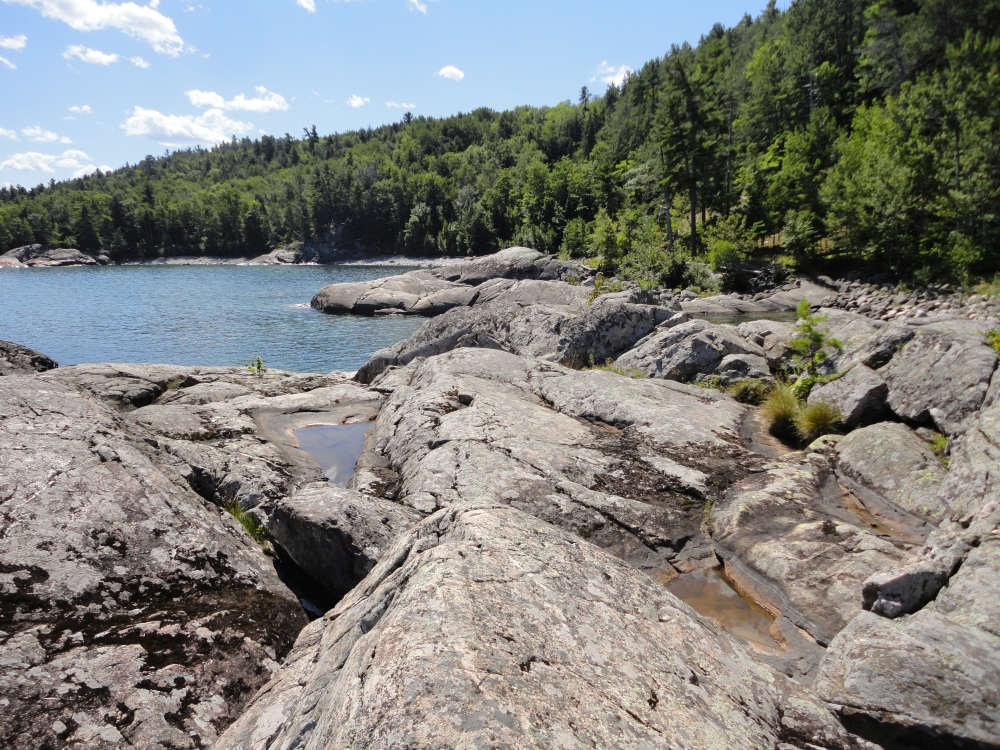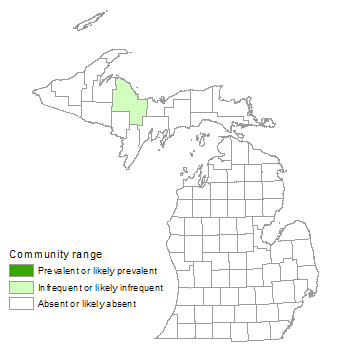Granite Bedrock Lakeshore
Overview
Granite bedrock lakeshore occurs along the Lake Superior shoreline as small knobs of sparsely vegetated granitic bedrock, typically between longer expanses of steep sandstone cliffs. Mosses and lichen dominate, with a few herbs, shrubs, and tree saplings and stunted trees restricted to areas above the strong influence of waves and ice scour. Granitic bedrock is restricted to scattered headlands (erosion-resistant knobs) along the Lake Superior shoreline between the city of Marquette and the Huron Mountain Club, about 48 km (30 miles) to the northwest. Granitic headlands include Sugarloaf Mountain (Wetmore Landing), Partridge Bay, Thoney Point, Saux Head Hill, and Granite Point. The Huron Islands, located just west of the Huron Mountains and about 10 km (6 miles) east of Point Abbaye, are the westernmost exposure of granitic bedrock along the southern shore of Lake Superior. Quartzite bedrock, which is included with the granitic rock types, is much less prevalent along the Lake Superior shoreline. A small outcrop of quartzite extends into Lake Superior approximately 3 km (2 miles) southeast of the city of Marquette, near Harvey.
Rank
Global Rank: G4G5 - Rank is uncertain, ranging from apparently secure to secure
State Rank: S2 - Imperiled

Landscape Context
A broad range of igneous and metamorphic rock, including gneiss, schist, granite, and quartzite, are often loosely referred to as “granitic” or “granite.” The granitic rock along the Lake Superior shoreline near the city of Marquette is among the oldest rock in the state, with coastal bedrock exposures that are approximately 2.3 billion years old. Small exposed knobs of the older granitic bedrock are typically surrounded by long expanses of younger, more recently formed Jacobsville sandstone cliffs. Quartzite bedrock east of Marquette was developed from quartz-rich sandstone, when the sandstone was deeply buried and the resulting high temperatures fused the quartz grains together to form an extremely hard quartzite rock highly resistant to weathering.
Granite bedrock lakeshore occurs as relatively small exposures, from 0.4 to 2.1 km (0.25 to 1.25 miles) in length and typically about 30 m (120 feet) wide. The entire bedrock feature typically extends farther inland, and grades into granite bedrock glade farther from the lake. Adjacent natural communities include sandstone lakeshore cliff, granite bedrock glade, granite lakeshore cliff, sand and gravel beach, boreal forest, dry-mesic northern forest, and mesic northern forest.
Soils
Because the granitic rocks along the coast are highly polished and extremely resistant to weathering, very little soil development takes place. Storm waves and ice scour also regularly remove developing soils. Freshly broken rock surfaces are circumneutral to mildly alkaline in pH, but the surface of weathered bedrock is acid. Some organic soil development takes place in cracks, under low shrubs, or in pools. Vascular plants are typically limited to these shallow cracks, exfoliation depressions, and pool edges where moisture and available nutrients are concentrated.
Natural Processes
Strong winds, waves, and winter ice create a stressed, unstable environment. Lack of soil development, combined with exposure to strong winds off Lake Superior, result in water stress for vegetation, although frequent coastal fog helps ameliorate these desiccating effects. Lightning strikes result in occasional tree mortality and fires. Wind storms maintain the open forest structure, causing blowdown of shallowly rooted trees. Fire and windthrow are both confined to the upland margin or “shrub zone” of granite bedrock lakeshore. Small pools occur where blocks of stone were plucked from the rock by glacial ice or loosened by freeze-thaw cycles and later removed by storm waves. Along Lake Superior, some larger rock pools remain flooded throughout the year and support vegetation only along their margins.
Vegetation
Many of the same herbs, shrubs, and trees found on granite bedrock glade and volcanic bedrock lakeshore also occur on granite bedrock lakeshore, but the arctic-subalpine species characteristic of the volcanic rock are typically absent. Common vascular species (80% or greater occurrence) of the open granitic lakeshore include ticklegrass (Agrostis scabra), harebell (Campanula rotundifolia), poverty grass (Danthonia spicata), hair grass (Deschampsia cespitosa), Canada bluegrass (Poa compressa), and low sweet blueberry (Vaccinium angustifolium). Other characteristic plants include paper birch (Betula papyrifera), three-toothed cinquefoil (Sibbaldiopsis tridentata), yarrow (Achillea millefolium), grass-leaved goldenrod (Euthamia graminifolia), and fireweed (Chamerion angustifolium). Farther from the lakeshore, shrubs, tree saplings, and stunted trees become relatively common on rounded slopes and summits of granitic knobs. Typical shrubs include bearberry (Arctostaphylos uva-ursi), bush honeysuckle (Diervilla lonicera), common juniper (Juniperus communis), mountain ash (Sorbus decora), mountain alder (Alnus viridis), and ninebark (Physocarpus opulifolius). Common tree species are white pine (Pinus strobus), quaking aspen (Populus tremuloides), northern white-cedar (Thuja occidentalis), white spruce (Picea glauca), and jack pine (Pinus banksiana). Low moist cliffs and vertical faces of boulders are dominated by lichens and ferns including fragile fern (Cystopteris fragilis), rusty woodsia (Woodsia ilvensis), and common polypody (Polypodium virginianum). Pools in the rock commonly support several herbaceous plants along their edges, including bluejoint grass (Calamagrostis canadensis), hair grass, bog lobelia (Lobelia kalmii), and wool-grass (Scirpus cyperinus).
The plant community consists of distinct zones with different dominants. Wave action and ice scour close to the lakeshore produce a “wave-washed zone” that is almost devoid of vegetation except for small tufts of mosses and lichen. Above this high-energy zone is a spray zone or open, vegetated zone, where the dominant vegetation consists of mosses and lichens, with lichen cover increasing with elevation above the water. Herbs and shrubs are restricted to bedrock cracks in the lower part of this zone, but become more common with increasing elevation above the lake. Above the strong influence of storm waves and ice scour, woody vegetation becomes dominant. Small pools occur where blocks of stone were removed by winter ice and storm waves, or were plucked from the rock knobs by glacial ice.
For information about plant species, visit the Michigan Flora website.
Plant Lists
Graminoids
- ticklegrass (Agrostis scabra)
- wavy hair grass (Avenella flexuosa)
- blue-joint (Calamagrostis canadensis)
- poverty grass (Danthonia spicata)
- tufted hair grass (Deschampsia cespitosa)
- wool-grass (Scirpus cyperinus)
Forbs
- yarrow (Achillea millefolium)
- harebell (Campanula rotundifolia)
- fireweed (Chamerion angustifolium)
- grass-leaved goldenrod (Euthamia graminifolia)
- wild strawberry (Fragaria virginiana)
- Kalm’s lobelia (Lobelia kalmii)
- cow-wheat (Melampyrum lineare)
- three-toothed cinquefoil (Sibbaldiopsis tridentata)
- old-field goldenrod (Solidago nemoralis)
Ferns
- fragile fern (Cystopteris fragilis)
- common polypody (Polypodium virginianum)
- rusty woodsia (Woodsia ilvensis)
Shrubs
- mountain alder (Alnus viridis)
- bearberry (Arctostaphylos uva-ursi)
- bush honeysuckle (Diervilla lonicera)
- common juniper (Juniperus communis)
- ninebark (Physocarpus opulifolius)
- wild rose (Rosa acicularis)
- low sweet blueberry (Vaccinium angustifolium)
- Canada blueberry (Vaccinium myrtilloides)
Trees
- paper birch (Betula papyrifera)
- white spruce (Picea glauca)
- jack pine (Pinus banksiana)
- red pine (Pinus resinosa)
- white pine (Pinus strobus)
- quaking aspen (Populus tremuloides)
- mountain-ash (Sorbus decora)
- northern white-cedar (Thuja occidentalis)
Noteworthy Animals
The high-energy environment of granite bedrock lakeshore appears to provide little stable habitat for terrestrial insects, but the sediments, rock surfaces, and pools are likely important habitat for aquatic invertebrates.
Rare Plants
- Trisetum spicatum (downy oatgrass, state special concern)
Rare Animals
- Falco peregrinus (peregrine falcon, state endangered)
- Haliaeetus leucocephalus (bald eagle, state threatened)
Biodiversity Management Considerations
Excessive trampling or off-road vehicle use can kill lakeshore vegetation. The loss of vegetation can accelerate soil loss through wind, rain, or wave action. After soil has been lost, soil development and plant reestablishment are slow. Invasive species that have the potential to reduce diversity and alter community structure of granite bedrock lakeshore include spotted knapweed (Centaurea stoebe), ox-eye daisy (Leucanthemum vulgare), common St. John’s-wort (Hypericum perforatum), Canada bluegrass (Poa compressa), Kentucky bluegrass (P. pratensis), hawkweeds (Hieracium spp.), sheep sorrel (Rumex acetosella), garden tansy (Tanacetum vulgare), and common mullein (Verbascum thapsus). Maintaining a mature, unfragmented forested buffer around granite bedrock lakeshores may help limit the local seed source for invasive species distributed by wind or birds. Monitoring and control efforts to detect and remove these and other invasive species will help maintain the native biodiversity of granite bedrock lakeshore and surrounding natural communities.
Variation
Because this plant community occurs on a broad range of igneous and metamorphic rocks, including gneiss, schist, granite, and quartzite, it may be possible to identify subtypes of this plant community.
Similar Natural Communities
Granite bedrock glade, volcanic bedrock lakeshore, volcanic lakeshore cliff, volcanic bedrock glade, sandstone bedrock lakeshore, sandstone lakeshore cliff, and limestone bedrock lakeshore.
Places to Visit
- Harvey, Gwinn State Forest Management Unit, Marquette Co.
- Little Presque Isle, Gwinn State Forest Management Unit, Marquette Co.
Relevant Literature
- Albert, D.A. 2007. Natural community abstract for granite bedrock lakeshore. Michigan Natural Features Inventory, Lansing, MI. 7 pp.
- Albert, D.A., P. Comer, D. Cuthrell, D. Hyde, W. MacKinnon, M. Penskar, and M. Rabe. 1997. The Great Lakes bedrock lakeshores of Michigan. Michigan Natural Features Inventory, Lansing, MI. 218 pp.
- Catling, P.M., and V.R. Brownell. 1999. The flora and ecology of southern Ontario granite barrens. Pp. 392-405 in Savannas, barrens, and rock outcrop plant communities of North America, ed. R.C. Anderson, J.S. Fralish, and J.M. Baskin. Cambridge University Press, Cambridge, UK. 480 pp.
- Faber-Langendoen, D., ed. 2001. Plant communities of the Midwest: Classification in an ecological context. Association for Biodiversity Information, Arlington, VA. 61 pp. + appendix (705 pp.).
- Given, D.R., and J.H. Soper. 1981. The arctic-alpine element of the vascular flora at Lake Superior. National Museums of Canada, Publication in Botany 10: 1-70.
- LaBerge, G.L. 1994. Geology of the Lake Superior region. Geoscience Press, Phoenix, AZ. 313 pp.
- Shure, D.J. 1999. Granite outcrops of the southeastern United States. Pp. 99-118 in Savannas, barrens, and rock outcrop plant communities of North America, ed. R.C. Anderson, J.S. Fralish, and J.M. Baskin. Cambridge University Press, Cambridge, UK. 480 pp.
- Soper, J.H., and P.F. Maycock. 1962. A community of arctic-alpine plants of the east shore of Lake Superior. Canadian Journal of Botany 41: 183-198.
For a full list of references used to create this description, please refer to the natural community abstract for Granite Bedrock Lakeshore.
More Information
Citation
Cohen, J.G., M.A. Kost, B.S. Slaughter, D.A. Albert, J.M. Lincoln, A.P. Kortenhoven, C.M. Wilton, H.D. Enander, and K.M. Korroch. 2020. Michigan Natural Community Classification [web application]. Michigan Natural Features Inventory, Michigan State University Extension, Lansing, Michigan. Available https://mnfi.anr.msu.edu/communities/classification. (Accessed: January 8, 2026).
Kost, M.A., D.A. Albert, J.G. Cohen, B.S. Slaughter, R.K. Schillo, C.R. Weber, and K.A. Chapman. 2007. Natural Communities of Michigan: Classification and Description. Michigan Natural Features Inventory, Report No. 2007-21, Lansing, MI.


